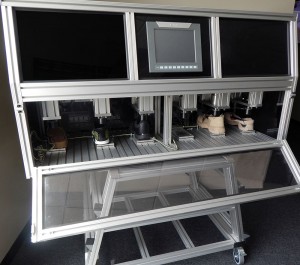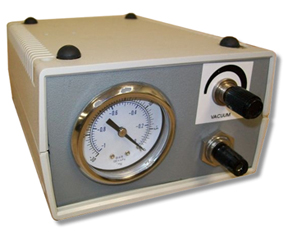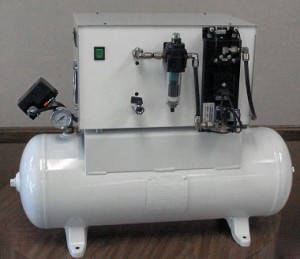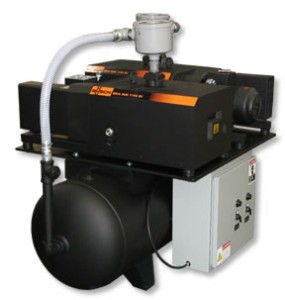 Brenner-Fiedler completed development of a servo controlled miter saw for an OEM customer. The customer, a manufacturer of saws, was looking for a team with knowledge and experience in servo controls. Based on our customer's requirements we designed a mechanics and controls package that fit within their cost target. The system uses an Omron servo motor, PLC, and HMI; a Shimpo planetary gearbox and ABB circuit protection.
Brenner-Fiedler completed development of a servo controlled miter saw for an OEM customer. The customer, a manufacturer of saws, was looking for a team with knowledge and experience in servo controls. Based on our customer's requirements we designed a mechanics and controls package that fit within their cost target. The system uses an Omron servo motor, PLC, and HMI; a Shimpo planetary gearbox and ABB circuit protection.
The system is accurate to less than a degree thanks to the servo accuracy and low backlash planetary gearbox. The angle can be controlled by either an HMI or rotary encoder. The customer has been provided with a detailed schematic, copies of the PLC and Servo Drive software, as well as diagrams of the control panel layout. Brenner-Fiedler will be stocking the components and delivering the PLC and drive pre-programmed to the customer.
Six-axis servo motion with PLC/HMI control - Watch the Video
Brenner-Fielder is pleased to announce the completion of custom Automated Shoe Testing equipment for a local customer. The customer has previously been using an off the shelf shoe tester but due to the high number of cycles and limited testing positions, they desired to be able to complete more tests on their shoes before release. The entirely custom machine was designed, built, and tested by Brenner-Fiedler. Featuring 6 stations, the new tester has three times the output of the old unit. The unit uses electric actuators from Bimba powered by servo motors from Quicksilver Controls to produce up to 1000N.
Because electric actuators were used as opposed to pneumatic actuators, energy is conserved over compressed air, the motion profile is more controlled, and the customer now has the ability to watch the sole of the shoe wear over time. The Unitronics PLC with 10.4" integrated HMI allows the user to interface with a color touch screen to change the number of cycles for a test, the target force, and the force tolerance. While running, the controller also captures the force applied to the shoe as well as the position of the actuator at force target (the thickness of the sole) every 100 cycles and saves directly to an SD card.

Challenge:
Customer required a discrete vacuum pump for a clinical lab environment that could operate at 100% duty cycle, vacuum adjustable, with On/Off switch and power cord complete with hose attachment.
The customer was using an MOA series vacuum pump with a potential quantity of 1000 units per year. They were happy with the performance of the pump but were not happy with the industrial look of the unit. They wanted something that could be placed in a patient’s room at a doctor’s office that was quiet and discrete.
Solution:
It was determined that a smaller vacuum pump (10D type) could be used to complete customer's requirements and still accommodate performance.
A fully enclosed vacuum pump (see picture) with the following description was created;
Fully enclosed vacuum pump (7.48 in L x 5.43 in. W x 3.149 in. H) with sound insulation for quiet operation. Unit includes 120V adaptor cord with ON/OFF switch and is equipped with a mechanical control knob to adjust vacuum level along with a 2-1/2 in. dial vacuum gauge for ease of view. Performance of vacuum pump is 4.3 lpm open, 14 inches Hg maximum vacuum, EDPM diaphragm and valve.

Challenge:
Company needed a small amount of clean, dry air and had no compressor.
Solution:
Brenner-Fiedler packaged an oil-less compressor, cooler and a dryer in a ventilated box to the customer’s satisfaction.

Challenge:
A same day surgery center needed a quiet, oil free central vacuum system to provide vacuum to each operating room. The system needed to reside outside with a small foot-print. They needed a system that had a long service life, requiring minimal service and maintenance. They previously used an oil sealed pump that had internal filters and needed to be serviced often and on a regular basis.
Solution:
Brenner-Fiedler assembled a duplex vacuum system with a special control panel on a small footprint. The motors were TEFC and since the unit would reside outside, everything was painted to avoid rust. The unit is extremely quiet. The contractor was able to mount this system outside since it met the noise requirements and the size specifications plus it was able to handle the weather. From there, the piping was run inside the facility and the vacuum system could operate without constant supervision.